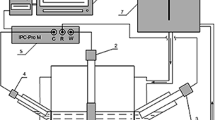Abstract
The electrodeposition of nickel from 0.5 M sulfate-succinate-chloride (I) and 0.3 and 0.5 M chloride-cuccinate (II) solutions at a temperature of 50°C is studied. It is found that, depending on the pH0 of solution and the concentration of succinic acid and nickel, the maximum cathodic current density for producing high-quality nickel deposits is to 35 A/dm2 in electrolytes I and to 60 A/dm2 in electrolytes II. This corresponds to the metal deposition rates to 23 and 48 A/dm2, respectively. It is shown experimentally that high buffer properties of solutions (succinate buffer) are one of the reasons for high permissible current densities of nickel electrodeposition. The computer-calculated data showed that the intensification of nickel electrodeposition is caused also by the acceleration of mass transfer due to the presence of a considerable fraction of nickel in the form of positively charged complexes and a high concentration of components stabilizing pHS in the near-cathode layer.
Similar content being viewed by others
References
Bek, R.Yu., Tsupak, T.E., and Shuraeva, L.I., Gal’vanotekh. Obrab. Poverkhn., 1992, vol. 2, p. 5.
Bek, R.Yu., Tsupak, T.E., and Shuraeva, L.I., Elektrokhimiya, 1998, vol. 34, p. 182 [Russ. J. Elektrochem. (Engl. Transl.), vol. 34, p. 165].
Lainer, V.I. and Kudryavtsev, N.T., Osnovy gal’vanostegii: (Fundamentals of Electroplating), Moscow: Metallurgizdat, 1953, part 1.
Gal’dikene, O.K. and Matulis, Yu.Yu., Tr. AN Lit. SSR, Ser. B., 1964, no. 4 (39), p. 61.
Tsupak, T.E., Bud’ko, V.P., Mekhtiev, M.A., and Kudryavtsev, N.T., in Noveishie dostizheniya v oblasti elektrokhimicheskoi obrabotki poverkhnosti metallov (Advances in the Field of Electrochemical Treatment of Metal Surface), Moscow: MKhTI, 1977, no. 95, p. 42.
Kudryavtsev, N.T., Tsupak, T.E., and Markina, V.V., USSR Inventor’s Certificate no. 281 986 (1970).
Kudryavtsev, N.T., Tsupak, T.E., and Marchenkov, Yu.M., USSR Inventor’s Certificate no. 508 564 (1976).
Kudryavtsev, N.T., Tsupak, T.E., Mekhtiev, M.A., and Marchenkov, Yu.M., Zashch. Met., 1977, vol. 13, p. 618.
Bek, R.Yu., Shuraeva, L.I., and Tsupak, T.E., Khim. Interesah Ustoich. Razvit., 1994, vol. 2, p. 589.
Tsupak, T.E., Bek, R.Yu., and Borodikhina, L.I., Elektrokhimiya, 1982, vol. 18, p. 86.
Bek, R.Yu., Tsupak, T.E., Shuraeva, L.I., and Kopteva, N.I., Zh. Prikl. Khim., 1996, vol. 69, p. 1880.
Bek, R.Yu., Tsupak, T.E., Nguen Zui Shi, Borodikhina, L.I. Elektrokhimiya, 1985, vol. 21, p. 1190.
Campi, E., Ann. Chim. (Roma), 1963, vol. 53, p. 553.
Smith, R.M. and Martel, A.E., Critical Stability Constants. V. 4. Inorganic Complexes, New York: Plenum, 1976.
Morris, D.E., Reed, G.L., Short, E.L., Slater, D.N., and Waters, D.N., J. Inorg. Nucl. Chem., 1965, no. 27, p. 377.
Dobos, D., Electrochemical Data. A Handbook for Electrochemists in Industry and Universities. Budapest: Akadémiai Kiadó, 1978.
McAuley, A. and Nancollas G. H., J. Chem. Soc., 1961, p. 4458.
Fedorenko, R.P., Vvedenie v vychislitel’nuyu fiziku (Introduction to Computational Physics), Moscow: Mosk. Fiz.-Tekhn. Inst., 1994.
Ibl, N. and Venczel, J., Metalloberfläche, 1970, vol. 10, p. 365.
Bek, R. Yu. and Tsupak, T.E., Elektrokhimiya, 1987, vol. 23, p. 560.
Brzyska, W. and Galkowska, B., Pol. J. Chem., 1998, vol. 72, p. 498.
Kheifits, V.L., Rotinyan, A.L., and Kozich, E.N., Zh. Obshch. Khim., 1954, vol. 24, p. 1486.
Bek, R.Yu., Shuraeva, L.K., and Tsupak, T.E., Zh. Prikl. Khim., 1998, vol. 71, p. 70.
Kharkats, Yu.I., Itogi Nauki Tekh., Ser.: Elektrokhim., Moscow: VINITI, 1991, vol. 38.
Author information
Authors and Affiliations
Corresponding author
Additional information
Original Russian Text © A.A. Sedoikin, T.E. Tsupak, 2008, published in Elektrokhimiya, 2008, Vol. 44, No. 3, pp. 343–350.
Rights and permissions
About this article
Cite this article
Sedoikin, A.A., Tsupak, T.E. The role of migration mass transfer in the electrodeposition of nickel from sulfate-chloride and chloride solutions containing succinic acid. Russ J Electrochem 44, 319–326 (2008). https://doi.org/10.1134/S1023193508030099
Received:
Published:
Issue Date:
DOI: https://doi.org/10.1134/S1023193508030099



